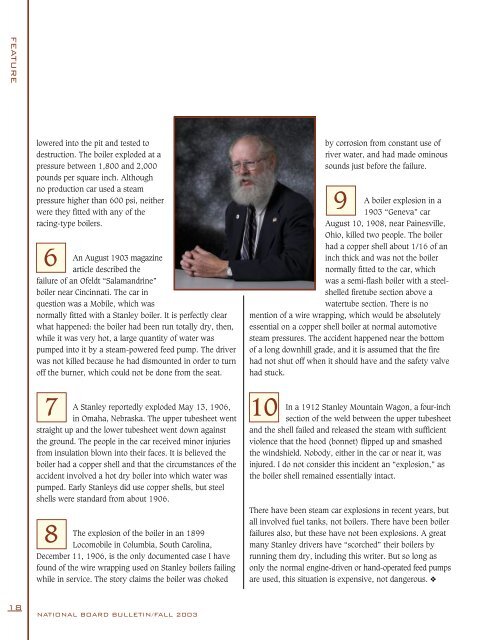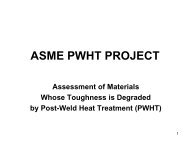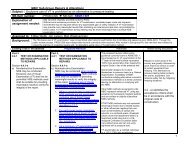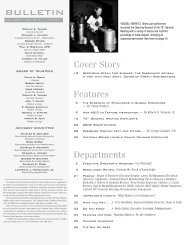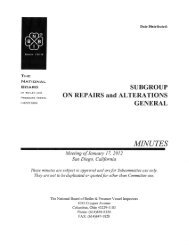bulletin - The National Board of Boiler and Pressure Vessel Inspectors
bulletin - The National Board of Boiler and Pressure Vessel Inspectors
bulletin - The National Board of Boiler and Pressure Vessel Inspectors
You also want an ePaper? Increase the reach of your titles
YUMPU automatically turns print PDFs into web optimized ePapers that Google loves.
FEATURE<br />
18<br />
lowered into the pit <strong>and</strong> tested to<br />
destruction. <strong>The</strong> boiler exploded at a<br />
pressure between 1,800 <strong>and</strong> 2,000<br />
pounds per square inch. Although<br />
no production car used a steam<br />
pressure higher than 600 psi, neither<br />
were they fitted with any <strong>of</strong> the<br />
racing-type boilers.<br />
6<br />
An August 1903 magazine<br />
article described the<br />
failure <strong>of</strong> an Ofeldt “Salam<strong>and</strong>rine”<br />
boiler near Cincinnati. <strong>The</strong> car in<br />
question was a Mobile, which was<br />
normally fitted with a Stanley boiler. It is perfectly clear<br />
what happened: the boiler had been run totally dry, then,<br />
while it was very hot, a large quantity <strong>of</strong> water was<br />
pumped into it by a steam-powered feed pump. <strong>The</strong> driver<br />
was not killed because he had dismounted in order to turn<br />
<strong>of</strong>f the burner, which could not be done from the seat.<br />
7<br />
A Stanley reportedly exploded May 13, 1906,<br />
in Omaha, Nebraska. <strong>The</strong> upper tubesheet went<br />
straight up <strong>and</strong> the lower tubesheet went down against<br />
the ground. <strong>The</strong> people in the car received minor injuries<br />
from insulation blown into their faces. It is believed the<br />
boiler had a copper shell <strong>and</strong> that the circumstances <strong>of</strong> the<br />
accident involved a hot dry boiler into which water was<br />
pumped. Early Stanleys did use copper shells, but steel<br />
shells were st<strong>and</strong>ard from about 1906.<br />
8<br />
<strong>The</strong> explosion <strong>of</strong> the boiler in an 1899<br />
Locomobile in Columbia, South Carolina,<br />
December 11, 1906, is the only documented case I have<br />
found <strong>of</strong> the wire wrapping used on Stanley boilers failing<br />
while in service. <strong>The</strong> story claims the boiler was choked<br />
NATIONAL BOARD BULLETIN/FALL 2003<br />
by corrosion from constant use <strong>of</strong><br />
river water, <strong>and</strong> had made ominous<br />
sounds just before the failure.<br />
A boiler explosion in a<br />
1903 “Geneva” car<br />
August 10, 1908, near Painesville,<br />
Ohio, killed two people. <strong>The</strong> boiler<br />
had a copper shell about 1/16 <strong>of</strong> an<br />
inch thick <strong>and</strong> was not the boiler<br />
normally fitted to the car, which<br />
was a semi-flash boiler with a steelshelled<br />
firetube section above a<br />
watertube section. <strong>The</strong>re is no<br />
mention <strong>of</strong> a wire wrapping, which would be absolutely<br />
essential on a copper shell boiler at normal automotive<br />
steam pressures. <strong>The</strong> accident happened near the bottom<br />
<strong>of</strong> a long downhill grade, <strong>and</strong> it is assumed that the fire<br />
had not shut <strong>of</strong>f when it should have <strong>and</strong> the safety valve<br />
had stuck.<br />
10<br />
9<br />
In a 1912 Stanley Mountain Wagon, a four-inch<br />
section <strong>of</strong> the weld between the upper tubesheet<br />
<strong>and</strong> the shell failed <strong>and</strong> released the steam with sufficient<br />
violence that the hood (bonnet) flipped up <strong>and</strong> smashed<br />
the windshield. Nobody, either in the car or near it, was<br />
injured. I do not consider this incident an “explosion,” as<br />
the boiler shell remained essentially intact.<br />
<strong>The</strong>re have been steam car explosions in recent years, but<br />
all involved fuel tanks, not boilers. <strong>The</strong>re have been boiler<br />
failures also, but these have not been explosions. A great<br />
many Stanley drivers have “scorched” their boilers by<br />
running them dry, including this writer. But so long as<br />
only the normal engine-driven or h<strong>and</strong>-operated feed pumps<br />
are used, this situation is expensive, not dangerous. ❖


